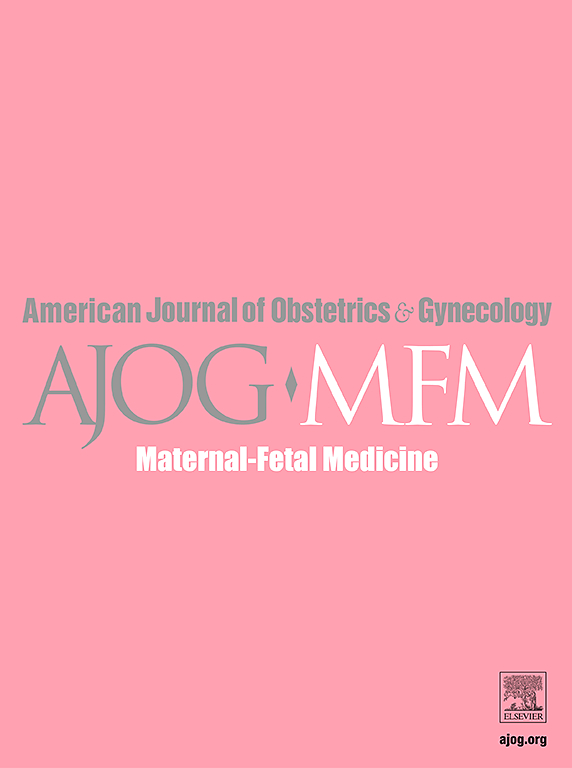The diagnostic role of miRNAs in identifying placenta Accreta: a systematic review
IF 3.8
2区 医学
Q1 OBSTETRICS & GYNECOLOGY
American Journal of Obstetrics & Gynecology Mfm
Pub Date : 2025-04-23
DOI:10.1016/j.ajogmf.2025.101682
引用次数: 0
Abstract
Objective
This systematic review evaluates the diagnostic accuracy of circulating microRNAs (miRNAs) as potential biomarkers for detecting placenta accreta spectrum (PAS) disorders, a condition characterized by abnormal placental adherence with significant maternal health risks.
Data Sources
A comprehensive literature search was conducted in PubMed, Embase, and Scopus databases up to October 30, 2024, using predefined keywords such as "miRNA" and “placenta accreta.”
Study Eligibility
Studies investigating miRNA expression in PAS cases compared to controls, using either blood or placental tissue, were included. Articles were screened independently by 2 reviewers, with discrepancies resolved by consensus.
Study Appraisal and Synthesis Methods
The methodological quality of eligible studies was assessed using the Newcastle-Ottawa Scale. Extracted data were synthesized to identify miRNAs with diagnostic potential for PAS disorders. Due to significant variations in the comparisons conducted across studies and the diverse outcome measures reported, a meta-analysis of the included studies was not feasible.
Results
Out of 82 articles identified, 14 met the inclusion criteria after duplicate removal and screening. The studies reported distinct differential expression patterns of miRNAs in PAS cases. Notably, a combination of miR-26a-5p and miR-17-5p demonstrated 100% sensitivity and 82% specificity for predicting PAS in the first-trimester of pregnancy.
Conclusions
PAS disorders are typically diagnosed during the third trimester through imaging techniques like ultrasonography. However, miRNAs exhibit promise as non-invasive, early biomarkers, potentially enabling earlier diagnosis and improved clinical management. These findings support the incorporation of miRNA analysis into diagnostic guidelines for PAS.
mirna在鉴别胎盘增生中的诊断作用:系统综述。
目的:本系统综述评估了循环microRNAs (miRNAs)作为检测胎盘增生谱(PAS)疾病的潜在生物标志物的诊断准确性,PAS是一种以胎盘粘附异常为特征的疾病,具有显著的孕产妇健康风险。数据来源:在PubMed, Embase和Scopus数据库中进行了全面的文献检索,截止到2024年10月30日,使用预定义的关键词,如“miRNA”和“胎盘增生”。研究资格:纳入了使用血液或胎盘组织研究PAS病例与对照组相比miRNA表达的研究。文章由两位审稿人独立筛选,差异通过共识解决。研究评价和综合方法:使用纽卡斯尔-渥太华量表评估合格研究的方法学质量。对提取的数据进行合成,以鉴定具有PAS疾病诊断潜力的mirna。由于各研究间进行的比较存在显著差异,报告的结果测量方法也不尽相同,因此无法对纳入的研究进行荟萃分析。结果:筛选出的82篇文献中,有14篇符合重复剔除和筛选的纳入标准。这些研究报告了PAS病例中mirna的明显差异表达模式。值得注意的是,miR-26a-5p和miR-17-5p的组合在预测妊娠早期PAS方面显示出100%的敏感性和82%的特异性。结论:PAS障碍通常在妊娠晚期通过超声等成像技术诊断。然而,mirna作为一种非侵入性的早期生物标志物,有望实现早期诊断和改善临床管理。这些发现支持将miRNA分析纳入PAS的诊断指南。
本文章由计算机程序翻译,如有差异,请以英文原文为准。
求助全文
约1分钟内获得全文
求助全文
来源期刊

American Journal of Obstetrics & Gynecology Mfm
Medicine-Medicine (all)
CiteScore
7.40
自引率
3.20%
发文量
254
审稿时长
40 days
期刊介绍:
The American Journal of Obstetrics and Gynecology (AJOG) is a highly esteemed publication with two companion titles. One of these is the American Journal of Obstetrics and Gynecology Maternal-Fetal Medicine (AJOG MFM), which is dedicated to the latest research in the field of maternal-fetal medicine, specifically concerning high-risk pregnancies. The journal encompasses a wide range of topics, including:
Maternal Complications: It addresses significant studies that have the potential to change clinical practice regarding complications faced by pregnant women.
Fetal Complications: The journal covers prenatal diagnosis, ultrasound, and genetic issues related to the fetus, providing insights into the management and care of fetal health.
Prenatal Care: It discusses the best practices in prenatal care to ensure the health and well-being of both the mother and the unborn child.
Intrapartum Care: It provides guidance on the care provided during the childbirth process, which is critical for the safety of both mother and baby.
Postpartum Issues: The journal also tackles issues that arise after childbirth, focusing on the postpartum period and its implications for maternal health. AJOG MFM serves as a reliable forum for peer-reviewed research, with a preference for randomized trials and meta-analyses. The goal is to equip researchers and clinicians with the most current information and evidence-based strategies to effectively manage high-risk pregnancies and to provide the best possible care for mothers and their unborn children.
 求助内容:
求助内容: 应助结果提醒方式:
应助结果提醒方式:


